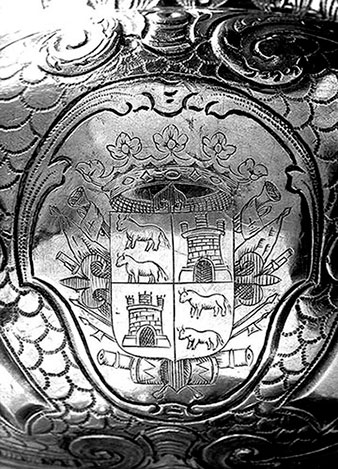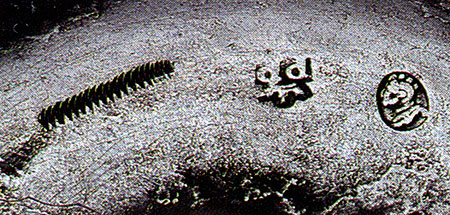The piece of the month of July 2018
THE SILVER ACETRE OF THE MARQUIS OF CASTELFUERTE, VICEROY OF PERU (1724-1736)
Cristina Esteras Martín
Chair of Navarrese Heritage and Art
One of the most illustrious figures of Navarre between the XVII and XVIII centuries was Don José de Armendáriz y Perurena (1670-1740), born in Pamplona into an aristocratic family, who devoted much of his life to the degree program of arms participating in the wars of Flanders (1690 and 1693) and Portugal, in addition to being present at the siege of Gibraltar (1704) as Field Marshal. Promoted to Lieutenant General (1706) he held posts in Extremadura commanding the royal troops in the battle of Lagudina (1708) and in Villaviciosa (1710). He was awarded the Order of Santiago in 1699 and on June 5, 1711 he was granted the degree scroll of Marquis of Castelfuerte.
Being Governor and Captain General of Guipuzcoa (1718-1723) he was appointed, at the age of 50, Viceroy and Captain General of the Kingdoms of Peru and Tierra Firme on October 4, 1723, embarking on December 31 with an entourage of forty people bound for Lima, where he made his official entrance under a canopy on May 14, 1724. His political government lasted no less than 11 years, one of the longest, and in which he promoted the first Bourbon attempt to reform Peru, returning to Spain in 1736 in the ship "San Fermin" (built under his mandate), at 65 years of age. Subjected by the prosecutor of the Audiencia of Lima to the Judgment of residency program his viceregal government was valued very favorably, recognizing that he was "good minister, viceroy, governor, captain general and president of the audience, assuring that he had acted with the rectitude, disinterest and prudence that was to be expected of so high position and dignity"; in addition he would be recognized as a great Catholic and A in the management of the ordination of the work miners.
Already in the peninsula he was promoted to Captain General, Degree that never had any Viceroy, and in 1737 Felipe V distinguished him with the Order of the Golden Fleece, whose symbols were imposed on him in Aranjuez on May 24, 1738. He would live in Madrid until his death, on April 16, 1740, being buried first in Madrid and later exhumed and transferred to the chapel of Our Lady of the Rosary, of the convent of Santo Domingo of Pamplona, although at the moment he rests in a mausoleum in the cemetery of this city. When he died unmarried and without descendants, his properties and noble titles passed to his younger brother Don Juan Francisco de Armendariz.

Portrait of the Viceroy Marquis of Castelfuerte.
Don José de Armendáriz was, as a Navarrese in the Indies, very generous with his land of origin, since in 1735 he had the main and side altarpieces of the convent of the Benedictine nuns of Corella (Navarra) built at his own expense, in addition to giving them important silver pieces (now disappeared): a monstrance, four candlesticks, sixty candlesticks and a large box-altarpiece with the Virgin of Copacabana (a typical piece of the Altiplano). He also gave other silverware to the Virgen del Camino of the parish of San Saturnino (Pamplona), also lost. Previously he sent an important gift from Lima, of which there is documentary evidence in 1730, to the chapel of San Fermín, in the parish of San Lorenzo, Pamplona, consisting of a gold chain of original links with a pectoral of the same material in which twenty emeralds are set, plus five fountains and two jugs (ewers) that, fortunately, are still preserved today.
In addition to the pieces mentioned above, there is in the Várez Fisa Collection (Madrid) a silver acetre that, by the heraldic arms that, twice, presents engraved with burin (in a quartered shield: 1st and 4th two cows set in a pole and 2nd and 3rd a castle; a cross of the Order of Santiago, a colonel as a ducal crown and flags, bugles, rifles, lances, halberds and drums, all typical of military men, as external ornaments on the flanks of the shield), it is confirmed that the piece belonged to Don José de Armendáriz y Perurena. However, as the acetre is out of context and without the orientation of where it was acquired, it is impossible, for now, to know if it had as initial destination one of the temples of the Viceroy's devotion or if it was commissioned for the service of his house.

Acetre Várez Fisa Collection.

Shield on the acetre.

Marks of Pamplona and José de Yábar.
In any case, whether it had one destination or another, what we do know, and it is very important, is that it was carved in Pamplona, and not sent from Peru, since the presence of the mark of that city (double PP under a crown of three points) plus another of subject heraldic (head of profile left with helmet touched with four pearls) allow, without doubt, such a Pamplona attribution, as well as to consign to the prestigious silversmith José de Yábar (1728-1773) the authorship of this acetre, since the sign of the helmet is one of the two personal variants that he used to seal his works. Documented between 1713 when he obtained his mastery and 1777, he moved stylistically under the forms of the Baroque, and later in those of the Rococo, being the acetre a work of plenary session of the Executive Council baroque and of extraordinary technical quality and good structural design , with a decorative repertoire in which triumphs the naturalistic adornment based on garlands with large open flowers and in bud, which are treated as a fine lace to be chiseled on a delicate background chopped luster.
Was it made while the Viceroy was in Lima or on his return from Peru when he settled in Madrid? It seems logical to think that the commission was made to a silversmith from Pamplona -and not to one of the many good Peruvian masters, from Lima or from any other artistic center of the Viceroyalty-, because Don José was already in Spain (since 1736), and as the coat of arms engraved on the acetre does not include the Golden Fleece awarded in 1737 and, therefore, essential to accompany his heraldry, therefore, essential to accompany his heraldry, we understand that it had to be made before that year and most probably between the dates of 1736 and 1737 (or May 1738, when the symbols were imposed on him), a period in which the work also fits stylistically.
The known artistic production of José de Yábar is fundamentally of a religious nature, as we only know of one privately-owned device, so that the Viceroy's plateware corroborates the silversmith's dedication to carving pieces for worship and confirms him as an excellent craftsman, worthy of the fame he had and for which he was in great demand.
SOURCES AND BIBLIOGRAPHY
ESTERAS MARTÍN, C., La platería de la Colección Várez Fisa. Selected works. Siglos XV-XVIII, Madrid, 2000, pp. 210-213.
FERNÁNDEZ GRACIA, R., "La escultura funeraria en Navarra durante el Renacimiento y el Barroco", Príncipe de Viana, Year 49, nº 183 (1988), pp. 51-69.
HEREDIA MORENO, M. del C. and ORBE SIBATTE, M. and A. de, Arte hispanoamericano en Navarra. Plata, pintura y escultura, Institución Príncipe de Viana, Government of Navarra, 1992, nº 115-119.
MIGUÉLIZ VALCARLOS, I., "Azafate de plata de José de Yábar", Pieza del Mes, Chair de Patrimonio y Arte Navarro, February 2008.
MORENO CEBRIÁN, A., The Viceroyalty of the Marquis of Castelfuerte, 1714-1736. El primer intento borbónico por reformar el Perú, Madrid, publishing house Catriel, 2000, 671 pp.
MORENO CEBRIÁN, A., "La liturgia de la muerte. Seis entierros y un sepulcro para José de Armendáriz y Perurena, virrey del Perú (1140-1901)", Histórica, vol. XXV, nº 2 (2001), pp. 161-210.
